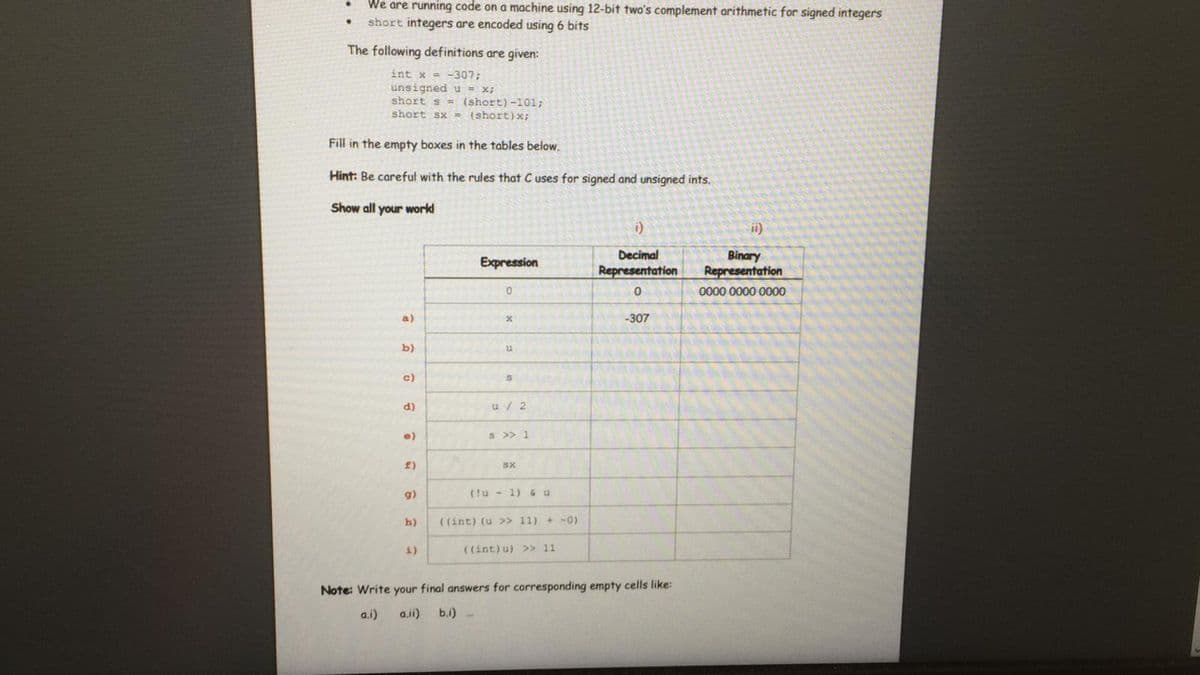machine using 12-bit two's complement arithmetic for signed integers short integers are encoded using 6 bits The following definitions are given: int x--307; unsigned u- x; short s (short) -101; short sx - (ahort)x; Fill in the empty boxes in the tables below. Hint: Be careful with the rules that Cuses for signed and unsigned ints. Show all your workd Decimal Binary Representation Expression Representation 0000 0000 0000 a) -307 b) c) d) u/ 2 e) > 1 g) (tu - 1)& u h) ((int) (u >> 11) +0) ((int) u) >> 11 Note: Write your final answers for corresponding empty cells like a.) a.i) b.i)
machine using 12-bit two's complement arithmetic for signed integers short integers are encoded using 6 bits The following definitions are given: int x--307; unsigned u- x; short s (short) -101; short sx - (ahort)x; Fill in the empty boxes in the tables below. Hint: Be careful with the rules that Cuses for signed and unsigned ints. Show all your workd Decimal Binary Representation Expression Representation 0000 0000 0000 a) -307 b) c) d) u/ 2 e) > 1 g) (tu - 1)& u h) ((int) (u >> 11) +0) ((int) u) >> 11 Note: Write your final answers for corresponding empty cells like a.) a.i) b.i)
Database System Concepts
7th Edition
ISBN:9780078022159
Author:Abraham Silberschatz Professor, Henry F. Korth, S. Sudarshan
Publisher:Abraham Silberschatz Professor, Henry F. Korth, S. Sudarshan
Chapter1: Introduction
Section: Chapter Questions
Problem 1PE
Related questions
Question
100%

Transcribed Image Text:We are running code on a machine using 12-bit two's complement arithmetic for signed integers
short integers are encoded using 6 bits
The following definitions are given:
int x = -307;
unsigned u = x;
short s = (short)-101;
short sx = (short)x;
Fill in the empty boxes in the tables below.
Hint: Be careful with the rules that Cuses for signed and unsigned ints.
Show all your workl
i)
i)
Binary
Representation
Decimal
Expression
Representation
0000 0000 0000
a)
-307
b)
c)
d)
u / 2
e)
s > 1
£)
g)
(!u - 1) &u
h)
((int) (u >> 11) + -0)
1)
((int) u) >> 11
Note: Write your final answers for corresponding empty cells like:
a.i)
a.ii)
b.i)
Expert Solution
This question has been solved!
Explore an expertly crafted, step-by-step solution for a thorough understanding of key concepts.
This is a popular solution!
Trending now
This is a popular solution!
Step by step
Solved in 2 steps

Knowledge Booster
Learn more about
Need a deep-dive on the concept behind this application? Look no further. Learn more about this topic, computer-science and related others by exploring similar questions and additional content below.Recommended textbooks for you

Database System Concepts
Computer Science
ISBN:
9780078022159
Author:
Abraham Silberschatz Professor, Henry F. Korth, S. Sudarshan
Publisher:
McGraw-Hill Education

Starting Out with Python (4th Edition)
Computer Science
ISBN:
9780134444321
Author:
Tony Gaddis
Publisher:
PEARSON

Digital Fundamentals (11th Edition)
Computer Science
ISBN:
9780132737968
Author:
Thomas L. Floyd
Publisher:
PEARSON

Database System Concepts
Computer Science
ISBN:
9780078022159
Author:
Abraham Silberschatz Professor, Henry F. Korth, S. Sudarshan
Publisher:
McGraw-Hill Education

Starting Out with Python (4th Edition)
Computer Science
ISBN:
9780134444321
Author:
Tony Gaddis
Publisher:
PEARSON

Digital Fundamentals (11th Edition)
Computer Science
ISBN:
9780132737968
Author:
Thomas L. Floyd
Publisher:
PEARSON

C How to Program (8th Edition)
Computer Science
ISBN:
9780133976892
Author:
Paul J. Deitel, Harvey Deitel
Publisher:
PEARSON

Database Systems: Design, Implementation, & Manag…
Computer Science
ISBN:
9781337627900
Author:
Carlos Coronel, Steven Morris
Publisher:
Cengage Learning

Programmable Logic Controllers
Computer Science
ISBN:
9780073373843
Author:
Frank D. Petruzella
Publisher:
McGraw-Hill Education